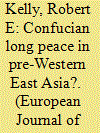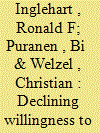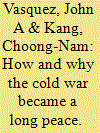| Srl | Item |
| 1 |
ID:
117052


|
|
|
|
|
| Publication |
2012.
|
| Summary/Abstract |
International Relations theory about East Asia has increasingly argued that East Asia before Western penetration enjoyed a protracted peace. As explanations, a Chinese military hegemony would fit realist theory fairly well, while a cultural peace based on shared Confucian norms would be a significant anomaly. A Confucian Long Peace challenges widely held, albeit Eurocentric, realist presumptions including the perils of anarchy, the arms-racing and misperception of the security dilemma, and the regularity of power balancing. This article therefore investigates, first, whether such a peace did in fact exist, and, second, whether this might be attributed to Confucianism. A cultural peace theory requires a strong anti-war cultural norm and a shared sense of community. Skepticism is established by examining three comparative cultural spaces that nonetheless did not enjoy a culturally informed peace: the classical Greek city-state system, early modern Christendom, and the contemporary Arab state system. All were deeply riven and competitive. Nevertheless, empirical investigation of the last Chinese (Qing) dynasty before the Western arrival (1644-1839) demonstrates that it was remarkably peaceful toward its Confucian neighbors, while more 'normally' exploiting its power asymmetry against non-Confucian ones. Process-tracing specialized Chinese practices toward fellow Confucians suggests that the low Confucian war finding emanates from cultural restraint.
|
|
|
|
|
|
|
|
|
|
|
|
|
|
|
|
| 2 |
ID:
140076


|
|
|
|
|
| Summary/Abstract |
The Democratic Peace thesis suggests that the absence of war between major powers since 1945 is caused by the spread of democracy. The Capitalist Peace thesis emphasizes trade and the rise of knowledge economies as the forces driving peace. Complementing these interpretations, we present empirical evidence of a cultural change that is making peace more desirable to the publics of most societies around the world. Analyzing public opinion data covering 90% of the world’s population over three decades, we demonstrate that improving existential conditions elevate the life opportunities of growing population segments and lead them to become increasingly tolerant of diversity and place growing emphasis on self-realization. In recognition of life’s rising opportunities, people’s valuation of life changes profoundly: readiness to sacrifice one’s life gives way to an increasing insistence on living it, and living it the way one chooses. Hence, pro-choice values rise at the same time as willingness to sacrifice lives in war dwindles. Historical learning based on the specific experiences of given societies has also changed their publics’ willingness to fight in wars. This transformation of worldviews places interstate peace on an increasingly solid mass basis.
|
|
|
|
|
|
|
|
|
|
|
|
|
|
|
|
| 3 |
ID:
119229


|
|
|
|
|
| Publication |
2013.
|
| Summary/Abstract |
A data-based analysis of how and why the long peace of the Cold War occurred. The analysis tests a proposition originally suggested by Senese and Vasquez (2008) that alliance polarization played an important role in producing the long peace, because in the 1816-1945 and post-Cold War periods, both sides having outside alliances was positively associated with the escalation of a militarized interstate dispute (MID) to war and in the Cold War it was negatively related. New hypotheses are derived to test this claim. Tests of two hypotheses support the claim that alliance polarization played a key role in the long peace, even when controlling for the presence of nuclear weapons.
|
|
|
|
|
|
|
|
|
|
|
|
|
|
|
|